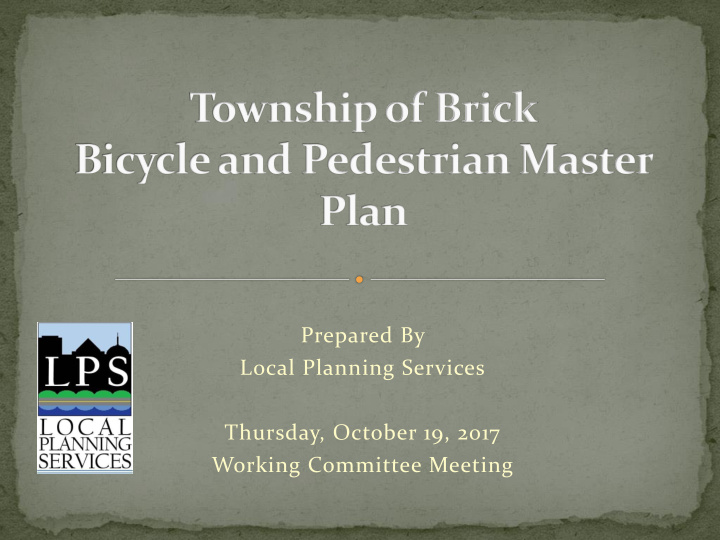



Prepared By Local Planning Services Thursday, October 19, 2017 Working Committee Meeting
Provide an overview of Existing Conditions 1. Solicit feedback from Working Committee 2. Discuss Next Steps 3.
18.5% of Brick’s population >65 population & 20.1% <18 State 14.4%/22.7%; County 21.7% /23.5% Youth and elderly (38.6%) most likely to walk/bike as means of transportation 0.1% of residents commute by bike and 1.1% by foot 6.4% of residents do not own a car 2.4% of residents commute by public transportation 6.7% of residents commute by carpooling 26% of County residents “Physically Inactive” & 28% are obese
Planning Documents Reviewed Master Plan Land Use Element, Recreation Element, and Circulation and Transportation Plan Element Brick Neighborhood Plans Cherry Quay-Bay Harbor, Brick Barrier Island, Princeton Midstreams, and Shore Acres Municipal Public Access Plan Route 70 Corridor Master Plan Zoning Ordinances Freight and Emergency Routes Neighboring Municipalities’ Bicycle and Pedestrian Plans Bay Head Complete Streets Bicycle and Pedestrian Plan, Toms River Pedestrian & Bicycle Mobility Summary Report, Point Pleasant Bicycle + Pedestrian Circulation Study, Lakewood Smart Growth Plan and Master Plan Circulation Element
Land Use Township Land Uses: Residential (predominantly single-family medium to high density) 47% of land in the Township Commercial 8%; Public property 26%; Vacant land 13% Township largely “built out” Very few large tracts of undeveloped land not designated as protected/conservation areas remaining in the Township Residential and commercial land uses are generally quite segregated Opportunities for future development largely in Town Center Overlay District Smart Growth goal of improving pedestrian linkages
490 miles of roadway and 18 intersections Principal Arterials State Rte 70, State Rte 88 (east of Rte 70), State Rte 35, Brick Blvd (CR 549), Chambers Bridge Rd (CR 549)
Transportation/Circulation (continued) Street layout presents challenges to bike/ped network connectivity Large geographic area, lack of grid network, natural impediments (i.e. creeks/rivers) Traffic congestion steadily increasing Minimal existing ped/bike infrastructure 2 miles of Princeton Avenue and 1.8 miles of Route 35 are the only roadways in Brick designated-on road bicycle lane and pavement markings Connectivity within residential neighborhoods generally good, but connections within commercial and mixed use areas, as well as between different uses, is poor Minimal public transportation, especially within neighborhoods
Transportation/Circulation (continued) Circulation Plan calls for the creation of a bicycle path network that connects residential neighborhoods to each other and to shopping centers and recreational areas, including beaches and open space. Route 70 Corridor in Brick’s “downtown” Opportunities to increase pedestrian and bicyclist access with targeted treatment Route 70 is the only connection between north and south
Bay Head Complete Streets Bicycle and Pedestrian Plan Smaller geographic area with grid layout Very walkable with a designated bike lane along Rte 35 Toms River Pedestrian & Bicycle Mobility Summary Report Goal to connect Barnegat Branch Trail to Downtown Toms River (10 miles south of Downtown Brick) through a developed area without major changes to right of way Point Pleasant Bicycle + Pedestrian Circulation Study Similar land use and transportation characteristics Recommends short, mid, and long term improvements to bike/ped network and identifies Rte 88, Herbertsville Rd, and Bridge Ave (which extend into Brick) as focus corridors Lakewood Smart Growth Plan and Master Plan Circulation Element Traffic congestion increasing due to rapid development Channeling Development into mixed-use centers (Downtown, proposed Cedarbridge Town Center, and proposed Cross and Prospect Street Core) and adding bike/ped connections
Brick Blvd and Chambers Bridge Rd are the two most dangerous roadways for pedestrians; with 7 and 6 pedestrian crashes respectively. With 6 crashes involving bicyclists Route 88 is the most dangerous for bicyclists. The most dangerous intersections for pedestrians cluster around the Town Center intersections of Brick Blvd and Mantoloking Avenue, Brick Blvd and Hooper Ave, Chambers Bridge Rd and Route 70. The most dangerous intersections for bicyclists cluster around the intersections of Princeton Ave, Route 88, and Route 70
Participants gave a median bikability score of 16.4 out of 30 , considered to be “okay, but not ideal” conditions with “plenty of room for improvement” Participants noted: Problems riding in road: “heavy and/or fast - moving traffic” (7 participants), “bicycle and/or paved shoulder disappeared” (6), “no space for bicyclists to ride” (4) Road surface issues “debris (e.g. broken glass, sand, gravel, etc.)” (8), “cracked and broken pavement” (7),“dangerous drain grates, utility covers, or metal plates” (4) Trouble riding through intersections: “Signal didn’t change for a bicycle” (6), “unsure where or how to ride through intersection” (6), “had to wait too long to cross intersection” (4).
Recommend
More recommend